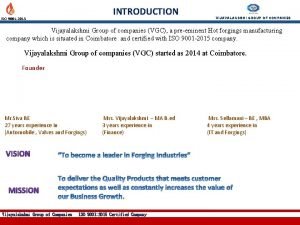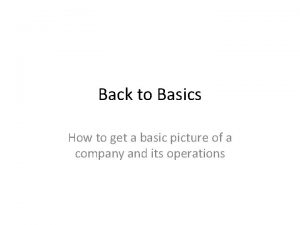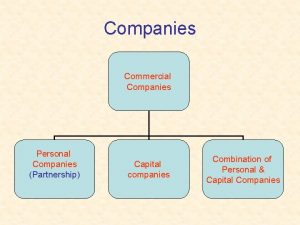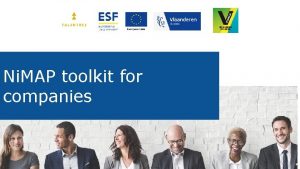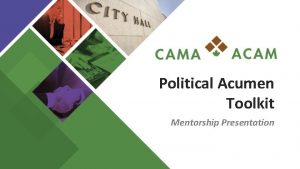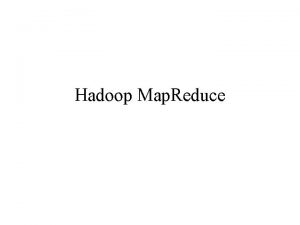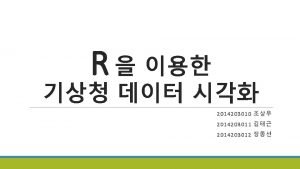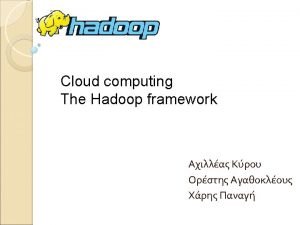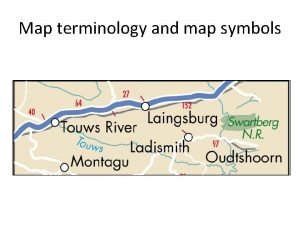Ni MAP toolkit for companies Ti Introduction This






































































































- Slides: 102

Ni. MAP toolkit for companies Ti

Introduction This training toolkit for companies has been developed by Vlerick Business School & Talentree to help companies create an inclusive and diverse work environment and to reap its benefits in the best possible way. The toolkit is based on the learnings gathered during the Newcomer Induction Management Accelerator Programme (Ni. MAP), a project which has been carried out in collaboration with Stockholm school of Economics and with the support of the European Social Fund. The training toolkit is divided into four different modules, which can be used separately or a whole, depending on the needs of companies.

Four modules 1. Multicultural diversity on the agenda 2. Building a diverse organisation: getting the foundations right 3. Recruiting for diversity 4. Managing diversity in the workplace

Ni. MAP MODULE 4 Managing diversity in the workplace Ti

Table of contents 1. Preparing and supporting diverse teams 1. Creating a clear team context 2. Effective communication 3. Building new competencies A great kick-off for new recruits 1. Onboarding 2. Extra attention for relocated talent 3. Local language training 4. Mentoring

1. Preparing and supporting diverse teams

Creating a clear team context

Creating a clear team context 1. Translating values to a code of conduct 2. Community building

Translating values to a code of conduct Frameworks help to: ● Align people within your organisation ● Handle dilemmas & make decisions ● Communicate your corporate values externally ● Benchmark performance ● Encourage discussions of ethics and compliance

How to build a strong code of conduct 1. Clarify your organisation’s mission, values and principles 2. Link to concrete standards of professional conduct 3. Make it concise and concrete 4. Check against real ethical dilemmas

Code of conduct: example JNJ

Code of conduct 1. Define 5 dilemmas you encountered/will encounter by bringing in more diversity in your teams 2. Discuss them with each other 3. Create a guideline on how to handle similar future dilemmas (linked to your company values) 4. Translate to a code of conduct

Community building ● Affinity groups to support identity and safety ● Opportunities to meet senior leaders ● Invitations to solve business problems ● Platforms to indicate identity-related issues ● Strong connection between majority and minority groups!

Effective communication

Effective communication 1. Joint language 2. Cross-cultural awareness and communication 3. Feedback culture

Joint language ● Corporate language: English ● Internal documents ● Email ● Informal communication ● Avoid jargon and metaphors

The case of Ghada, a 30 years old Syrian woman, joined the administrative cell of an international pharmaceutical company 2 months ago. She works as administrative assistant for the Belgian division of the company. The administrative team consists of 4 other assistants who have been working together for a long time and form a close group. The team likes to have lunch together in the company restaurant, where they jauntily discuss the novelties of the day. However, Ghada does not join her colleagues for lunch. As she doesn’t really master the Dutch language, she doesn’t understand what they’re talking about and can’t participate in the conversations. She would love to join her team members and get to know them better, but doesn’t dare to. Her modest character holds Ghada back from asking her colleagues to talk in English instead of Dutch. She thinks that would be quite an impolite request as she does not want to force people to adapt to her individual needs. The administrative team on the other hand, thinks Ghada is acting rude and uninterested. They interpret her behaviour as a clear sign of a lack of effort to integrate and decide to speak to their supervisor about Ghada’s “inappropriate behaviour”.

The case of Ghada ● ● What would you do if you were Ghada? What would you do if you were the supervisor of the administrative unit?

Cross-cultural awareness and communication ● Cross-cultural awareness & communication training can provide employees with the knowledge, skills and expertise to collaborate effectively across cultures ● Models that are frequently used within such trainings: ○ Hofstede ○ Trompenaars ○ Lewis

Hofstede’s model of national culture Power Distance Individualism vs Collectivism Indulgence vs Restraint Culture Long vs Short term orientation Masculinity vs Femininity Uncertainty avoidance

Hofstede’s model of national culture Use the country comparison tool to compare countries (https: //www. hofstede-insights. com/country-comparison/)

Trompenaars’ 7 D model

Lewis’ cultural types model Three behavioural categories: 1. Linear-active 2. Multi-active 3. Reactive

Do’s and don’ts For each behaviour, write down one do and one don’t for the 3 countries

Exercise: do’s and don’ts Behaviours Belgium Netherlands … Japan … Way of greeting Informal communication Decision making Feedback giving Handling emotions Dealing with hierarchy

Feedback culture Giving and receiving feedback is: ● Crucial for personal/professional development ● Culture-dependent e. g. open door policy

Situation-Behavior-Impact Model (SBI) S B I Situation Example Describe the situation. Be specific about when and “This morning at the 11 a. m. team meeting …” where it occurred. Behaviour Example Describe the observable behaviour. Keep to the “You interrupted me while I was telling the team facts. Don’t insert opinions or judgements, and about the monthly budget” don’t assume you know what the other person was (instead of “You were rude. ”) thinking. Impact Describe what you thought or felt in reaction to the behaviour. Example “I felt frustrated when you interrupted me because it broke my train of thought. ”

Non-violent communication 1. Observation: “When is see…” 2. Feelings: “I feel…” 3. Needs: “Because I need…” 4. Request: “Would you be willing to…”

Feedback culture Non-violent communication: Last week you didn't meet your deadline on handing in the paperwork for project X (Observation). This made me feel really stressed because I was waiting for it to finish my own work (Feelings). It would help if I knew beforehand if you can't reach a deadline so I can adapt the scheme or we can set priorities (Need). So, next time can you communicate earlier so we can follow up closely on the deadline (Request).

Flawless feedback 1. Read the case 2. Give feedback using the SBI or non-violent communication technique

Build new competencies

Effective formal training ● Targets awareness and skill development ● Occurs over a significant period of time ● Stimulates perspective-taking ● Incorporates goal-setting ● Includes all levels of the company ● Links diversity training with current processes

Most important competencies ● Inclusive leadership skills ● Handling bias ● Cross-cultural awareness & communication

Exercise: I am, but I am not 1. In the first column (‘I Am’): write down your race/religion/… 2. In the second column (I Am Not): write down associated stereotypes (positive/negative)

2. A great kick-off for new recruits

Onboarding is key

Why is onboarding important? ● Make employees feel included from day 1 ● Onboarding lays the foundation for someone’s career within the company

Why is onboarding important?

It even starts before day 1

Do not assume newcomers already know…

Most important onboarding elements 1. Share your company culture, strategy and code of conduct 2. Discuss performance expectations and development needs 3. Make sure all practical arrangements are made 4. Facilitate interactions with different stakeholders 5. Assign a mentor 6. Give and ask feedback (check-ins)

Learning on the job ● Learning on-the-job initiatives as a means to introduce new types of talent in your company ● Different formulas ● A lot of advantages: ○ Low risk ○ Learning by both sides ○ In case of a fit, a very engaged hire

Extra attention for relocated talent

Extra attention for relocated talent ● Administrative formalities ● Partners & family

Local language training

Belgium: a country of many languages ● 3 official languages: ○ Dutch ○ French ○ German ● … and many regional dialects

External language training ● Different formats (immersion courses, evening/weekend courses, …) - during working hours? ● Different channels (classroom setting, lessons over the phone, skype, …) ● Different providers: ○ Universities ○ Public employment services (VDAB, Forum, Actiris) ○ Adult education centers

External language training

Language training on the workfloor Highly-educated newcomers show a steep learning curve when they get the chance to practice language on the work floor, and not only in classroom settings.

Mentoring

Mentoring ● Two-way relationship between mentor and mentee ● Focus on personal challenges, feelings, and experiences ● Practical support ● Mentoring is a learning opportunity for both mentee and mentor!

Effect on bias ● Mentorship can decrease bias through intergroup contact ● Frame mentorship programmes as mutual learning processes and avoid hierarchical relations

Why investing in diverse mentoring programmes? ● Positive signal about diversity ● Establish connections between groups ● Building (diverse) networks ● Spreading ideas ● Higher chances of promotion rates for (diverse) mentees

Matching mentor and mentee ● A good match is a key determinant of success ● Make informed decisions ○ Wants and interests of the (potential) mentor ○ Needs and interests of the mentee ○ Use of questionnaires ● Mentor can be an employee of the same organisation, but can also be linked to an external organisation

Mentorship for diverse job seekers ● Several organisations have as their core business to link a mentor (often a volunteer) to a person of foreign origin who recently arrived in a guest country (the mentee) ● Focus on getting to know to national job market, finding the right search strategy, writing CVs and cover letters, … ● www. talent 2 connects organisations with different mentoring initiatives

Mentorship for diverse job seekers “An enriching experience that builds bridges between different cultures and ages: a win-win!” (Eva, 55 years old, mentor at DUO)

For more exercises on module 4: check our exercise leaflets! ● Role plays ● The dilemma debate ● Ginger man ● Empathy map ● A clear image ● Checklist for companies

Thank you Ti

Contact us Prof Dr Dirk Buyens Hannelore Waterschoot Dr Emmy Defever Programme Director Project Manager Vlerick Business School Talentree Vlerick Business School dirk. buyens@vlerick. com hannelore@talentree. com emmy. defever@vlerick. com

Ni. MAP MODULE 4 Appendix: Dilemma’s Ti

“PARTY TIME” Dilemma Ti

Party time There is a teambuilding activity planned for next Friday. The day will be finished with a dinner and a little party. Talita, a new team member will help to organize the day. Talita’s religion prohibits consumption of alcohol. She says she has a problem with the fact that alcohol will be served that evening. How do you deal with the situation?

“COMPLICATED ART” Dilemma Ti

Complicated art George’s screensaver shows an artwork of Michelangelo portraying a naked man. Axana is sitting next to George in the office and sees the picture often. Axana’s culture does not allow her to see naked men other than her husband. She wants George to change the picture but George refuses. How do you deal with the situation?

“TAKE IT OR LEAVE IT” Dilemma Ti

Take it or leave it Bettina is wearing a burqa and applies for a job within your company. The policy of your company however does not allow to wear burqas for safety reasons. During the selection process Bettina explicitly says that she is not willing to take the burqa off. How do you deal with the situation?

“HAPPY NEW YEAR” Dilemma Ti

Happy new year Zi Ying wants to take one month off in February to celebrate Chinese New Year together with her family. In Chinese culture, it is an important moment to be with your family. She couldn’t make it last year because she was in the middle of her new adventure in Europe. It is not allowed in your company to take a long holiday outside the summer months. Even in summer, there is an agreement that people do not take more than 3 weeks off in a row. How do you deal with the situation?

“HO HO HO” Dilemma Ti

HO HO HO You work in an international company and are leading the committee who’s responsible for organising fun activities throughout the year. During the Christmas period, you have arranged Santa Claus to pay a visit and provided all employees with chocolate and Christmas cookies. Afterwards, you received the comment that this was not appropriate in an international environment. How do you deal with this situation?

“COMPRIS? ” Dilemma Ti

Compris? You work in an international Belgium-based company where English is used as the common business language. To make international employees feel welcome, everyone is requested to speak English. There is a department where mostly French people are working. They often speak French amongst each other (in the office or during lunch breaks). How do you deal with this situation?

“A TRIP TO SAUDI ARABIA” Dilemma Ti

A trip to Saudi Arabia Patrick falls ill and because of this, he cannot accompany the CEO to a meeting in Saudi Arabia. A replacement needs to be found but it can only be a male colleague. Eva, who really wanted to go, lets you know this is unfair. How do you deal with this situation?

“ORA ET LABORA” Dilemma Ti

Ora et labora Bilal, a Muslim who works already for 1 year at your company, asks you if it is possible to have a prayer room in the company. How do you deal with this situation?

“SAY HI” Dilemma Ti

Say hi Your newly hired employee, Kaleb, an orthodox Jew, refuses to shake hands with a woman due to respect for that woman. How do you deal with this situation?

“LANGUAGE” Dilemma Ti

Language game You work in an international company located in Flanders. Recently, a colleague was hired who only speaks English and no Dutch. This requires an effort from the team members to switch to English. The new hire feels a bit guilty because the colleagues need to adapt. He doesn’t want to bother them too much, that’s why he doesn’t join them for lunch. The team members, however, believe their new colleague does not want to integrate within their team. How would you deal with this situation?

“HUGS AND KISSES” Dilemma Ti

Hugs and kisses Kalila starts working for a company where people are greeting each other in a rather informal way, by kissing and hugging. Kalila does not feel comfortable about this. How would you deal with this situation?

“LUNCH TIME” Dilemma Ti

Lunch time Emir does not want to eat in the cafeteria of the company because they serve pork. However, he is aware that lunch time is an important moment to get to know the colleagues in an informal way and since he is new in the company, he finds it extra important to have those moments with his colleagues. How would you deal with this situation?

“WHAT SHE SAYS” Dilemma Ti

What she says Ravi who is new in the company, does not accept orders from a woman. In meetings, he isn’t even listening when a woman is speaking. How would you deal with this situation?

“THE SOCIAL EVENT” Dilemma Ti

The social event The international employees within your company have no local friends. That’s why they start establishing an international community amongst them. They organise an event with international food at work and forget to invite the locals. How would you deal with this situation?

“THE HEADSCARF” Dilemma Ti

The headscarf Yasmine is working in the company for a couple of months now and she shows strong performance. You notice that 2 direct colleagues are sceptical about the fact that she’s wearing a headscarf. These colleagues exclude her from informal talks, and they even did not invite her to a team brainstorm. How would you deal with this situation?

“THE SOCIAL TALK” Dilemma Ti

The social talk Marcella recently joined a team where she’s the first international. After a couple of weeks she indicates that she’s feeling lonely. She misses the more informal activities and social talk, which was part of the work culture in her country of origin. How would you deal with this situation?

“SHAKE” Dilemma Ti

Shake shake Ali recently joined a company where it’s common practice to shake hands, everytime someone arrives or leaves the office. You notice that Ali does wants to shake hands with women. How would you deal with this situation?

“WEEKEND WORK” Dilemma Ti

Weekend work Yonsha applied for the position of Lab Technician in a medical laboratory. The line manager is very convinced that she’s right for the job: she has the technical skills as well as a positive attitude. However, there’s one problem: during the interview she clearly stressed she does not want to work on Saturdays due to religious reasons. Other team members follow a work schedule with Saturday work every three weeks. How would you deal with this situation?

“RAMADAN” Dilemma Ti

Ramadan Mari applied for the open position in the operations team (which consists of 10 people). He’s suitable for the job, but he participates in Ramadan. As the operations team already has 2 employees who participate in Ramadan, the line manager fears hiring Mari would make the team schedule even more tricky than it already is. How would you deal with this situation?

“TENSE ATMOSPHERE” Dilemma Ti

Tense atmosphere Ajwad and Tayeb are two employees of the same team. They do net get along at all, argue all the time and even physically fought each other once. Reason for their mutual hostility is their different origins: they’re descended from two rival Berber families. How would you deal with this situation?

Thank you Ti

Contact us Prof Dr Dirk Buyens Hannelore Waterschoot Dr Emmy Defever Professor HR and Partner Managing Partner Senior Researcher Vlerick Business School Talentree Vlerick Business School dirk. buyens@vlerick. com hannelore@talentree. be emmy. defever@vlerick. com +32 9 210 97 11 +32 473 89 42 37 +32 9 210 97 56
 Introduction to corporate finance
Introduction to corporate finance Formuö
Formuö Typiska novell drag
Typiska novell drag Nationell inriktning för artificiell intelligens
Nationell inriktning för artificiell intelligens Returpilarna
Returpilarna Shingelfrisyren
Shingelfrisyren En lathund för arbete med kontinuitetshantering
En lathund för arbete med kontinuitetshantering Kassaregister ideell förening
Kassaregister ideell förening Tidböcker
Tidböcker Anatomi organ reproduksi
Anatomi organ reproduksi Förklara densitet för barn
Förklara densitet för barn Datorkunskap för nybörjare
Datorkunskap för nybörjare Tack för att ni lyssnade bild
Tack för att ni lyssnade bild Tes debattartikel
Tes debattartikel För och nackdelar med firo
För och nackdelar med firo Nyckelkompetenser för livslångt lärande
Nyckelkompetenser för livslångt lärande Påbyggnader för flakfordon
Påbyggnader för flakfordon Lufttryck formel
Lufttryck formel Offentlig förvaltning
Offentlig förvaltning Jag har gått inunder stjärnor text
Jag har gått inunder stjärnor text Presentera för publik crossboss
Presentera för publik crossboss Argument för teckenspråk som minoritetsspråk
Argument för teckenspråk som minoritetsspråk Plats för toran ark
Plats för toran ark Klassificeringsstruktur för kommunala verksamheter
Klassificeringsstruktur för kommunala verksamheter Fimbrietratt
Fimbrietratt Bästa kameran för astrofoto
Bästa kameran för astrofoto Cks
Cks Lågenergihus nyproduktion
Lågenergihus nyproduktion Mat för unga idrottare
Mat för unga idrottare Verktyg för automatisering av utbetalningar
Verktyg för automatisering av utbetalningar Rutin för avvikelsehantering
Rutin för avvikelsehantering Smärtskolan kunskap för livet
Smärtskolan kunskap för livet Ministerstyre för och nackdelar
Ministerstyre för och nackdelar Tack för att ni har lyssnat
Tack för att ni har lyssnat Referatmarkeringar
Referatmarkeringar Redogör för vad psykologi är
Redogör för vad psykologi är Matematisk modellering eksempel
Matematisk modellering eksempel Atmosfr
Atmosfr Borra hål för knoppar
Borra hål för knoppar Orubbliga rättigheter
Orubbliga rättigheter Beräkna standardavvikelse
Beräkna standardavvikelse Tack för att ni har lyssnat
Tack för att ni har lyssnat Rita perspektiv
Rita perspektiv Vad är verksamhetsanalys
Vad är verksamhetsanalys Tobinskatten för och nackdelar
Tobinskatten för och nackdelar Toppslätskivling effekt
Toppslätskivling effekt Modell för handledningsprocess
Modell för handledningsprocess Egg för emanuel
Egg för emanuel Elektronik för barn
Elektronik för barn Plagg i gamla rom
Plagg i gamla rom Strategi för svensk viltförvaltning
Strategi för svensk viltförvaltning Var 1721 för stormaktssverige
Var 1721 för stormaktssverige Ellika andolf
Ellika andolf Romarriket tidslinje
Romarriket tidslinje Tack för att ni lyssnade
Tack för att ni lyssnade Samlade siffror för tryck
Samlade siffror för tryck Dikt fri form
Dikt fri form Inköpsprocessen steg för steg
Inköpsprocessen steg för steg Rbk-mätning
Rbk-mätning Etik och ledarskap etisk kod för chefer
Etik och ledarskap etisk kod för chefer Exspektans eller expektans
Exspektans eller expektans Myndigheten för delaktighet
Myndigheten för delaktighet Frgar
Frgar Tillitsbaserad ledning
Tillitsbaserad ledning Läkarutlåtande för livränta
Läkarutlåtande för livränta Punkthöjd karttecken
Punkthöjd karttecken Gumman cirkel
Gumman cirkel Shaktismen
Shaktismen Biologiska arvet
Biologiska arvet Bris för vuxna
Bris för vuxna Bamse för de yngsta
Bamse för de yngsta Lindsay waste collection
Lindsay waste collection Valuation of private companies
Valuation of private companies Social media for asset managers
Social media for asset managers Company diversification strategy
Company diversification strategy People leave bosses not companies
People leave bosses not companies Golden rule of framing the prospectus means
Golden rule of framing the prospectus means Political risk insurance companies
Political risk insurance companies Melaleuca vs amway
Melaleuca vs amway Ethnocentric, polycentric geocentric
Ethnocentric, polycentric geocentric Book publishers in louisiana
Book publishers in louisiana Criminal liabilities of an auditor
Criminal liabilities of an auditor Semiconductor ip company
Semiconductor ip company Vijayalakshmi forgings
Vijayalakshmi forgings Holding company definition
Holding company definition Grenada trash service
Grenada trash service Viohalco
Viohalco Public companies in trinidad and tobago
Public companies in trinidad and tobago Elizabethan theatre flags
Elizabethan theatre flags Computer engineering companies
Computer engineering companies Appointment of registered valuer under companies act, 2013
Appointment of registered valuer under companies act, 2013 Zaloni
Zaloni Meaning of mnc company
Meaning of mnc company Unit 3 companies
Unit 3 companies Companies act 2015 fiji
Companies act 2015 fiji A strategy of diversifying into unrelated businesses
A strategy of diversifying into unrelated businesses Monopolistic competition example
Monopolistic competition example Rivalry chapter 5
Rivalry chapter 5 Strategic management in multinational companies
Strategic management in multinational companies Overhead cost per unit
Overhead cost per unit Related and unrelated diversification
Related and unrelated diversification Analyzing the marketing environment summary
Analyzing the marketing environment summary Wck companies house
Wck companies house



















































































